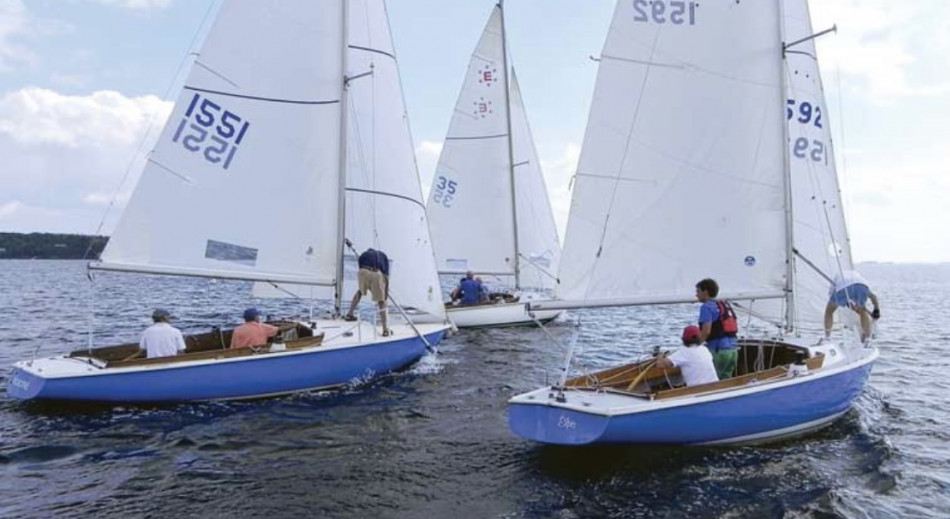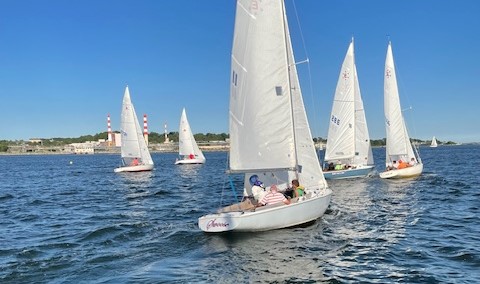This is about some lessons learned sailing in a new area and in a new (to me) boat. Just started sailing and racing again having moved from the Caribbean to the US. Met some people over the summer and got invited to do some racing on some different boats. So here are some lessons remembered and learned during my first season sailing in a new area.
The Location
The area that I find myself sailing in is the Long Island Sound and mostly the eastern end. Just about everyone I met has commented that this must be a major change compared to sailing in the Caribbean. They are always amazed when I tell them that the conditions here in LIS are almost exactly like in Trinidad.
Just about all the other Caribbean islands are like the tourist brochures. Blue seas, clear water, trade winds and open sea swells. Trinidad is the exception. The sailing there is done in the Gulf of Paria, which is an almost fully enclosed body of water between Trinidad and Venezuela. The same relatively shallow water and color as LIS. Strong tides and currents, relatively fresh sea water from rivers emptying into it and short, steep chop when the wind blows. No really constant trade winds because of the land masses surrounding it, so different wind directions and strengths are normal depending on the time of year.
In the summer, sailing on LIS was exactly the same as many days spent sailing in Trinidad. The big difference came in the Fall when the winds picked up and the temperature dropped. I suspect it will be the same in the Spring. First lesson learned. Get the right sailing gear for the conditions. Cold is not something Caribbean people accustomed to dealing with!
The Boat

I put my name up on a couple crew boards on some yacht club websites. This was a good lesson for me as I did not know anyone in the sailing community in the area. As a result I was invited to sail in a Wednesday evening race on a 44′ cruiser racer and it went from there. I’ve since sailed on a few other older IOR type race boats as I’ve gotten to know people. But for purpose of this blog I’ll concentrate on the boat that I ended up sailing on the most. An Ensign.
The Ensign, designed by Carl Alberg and built by Pearson Yachts, is the largest class of full keel sailboats in North America.
It is 22 and 1/2 feet long and weighs about 3,000 pounds. There have been about 2,000 built since 1962!
Lessons for being Crew
So, here I am sailing on an Ensign for the first time, having never laid eyes on one, or even known of their existence. Here I remembered another lesson that I’ve used throughout my life, especially when sailing with new boats or people. “Eyes and ears open mouth closed”. This lesson works for all sailors, whether a newbie or an experienced sailor.
Every boat and crew have their own ways of doing things and I always find it easier to learn their system rather than try to change it. This helps you to fit in easier and be a part of the team. Especially if it’s a race and there are other new people aboard. Take your cues from the skipper or owner. For newbies, ask questions when you don’t know or understand a task given to you. For experienced hands, volunteer to rig the boat or anything else that needs doing.
Generally I stay quiet unless asked my opinion or until I get a feel for the culture on the boat. The most important thing about sailing is to have fun. You can normally tell after one sail whether you had a good time and want to go again or, if it wasn’t enjoyable or comfortable. Honestly I can count on one hand the amount of times I haven’t had a good experience on boats. Compared to the countless times that I’ve really enjoyed it and the people I’ve sailed with.
Racing Lessons
Luckily I meshed with the owner of the boat and ended up sailing a five race series. It’s always a steep learning curve getting in an unfamiliar boat and getting it up to speed. Lessons learned here are the same no matter what boat you race. First on the list is the crew. The boat can be raced with 3-4 crew. Not using a spinnaker means you can get away with having only 2 crew but you suffer in heavier winds. Unfortunately we had 2 crew for half the races and a different third crew for the others. First lesson and job is to get 3 regular crew for next season.
First couple of races we sailed the boat as it was set up. Learned a lot about crewing in the boat, especially as we were short-handed. Got comparisons of our speed compared to our competitors. We were slow and finished last in the fleet but learned a lot! Most important lesson here was getting to know who the fast boats were. In a new class it’s always good to see the set-ups of the consistently fast boats and race winners. Imitation is a good shortcut to get you to a starting point. We adjusted our rig tensions tighter to more closely match the other boats and in the process found a stripped turnbuckle.
We were faster with the new rig tune and able to keep up better in the next race. Windy and with only 2 crew, as compared to 3-4 crew on the other boats, meant more lessons for us. The Outhaul and Backstay adjusters were very difficult to use. As well as the Traveler. Off season project is to upgrade some of the deck hardware, to make them easier to operate and reach while sailing. Small adjustments that will reap big rewards. Broke the main sheet block on the last and windiest race so a good reminder to go through all fittings and fastenings before next season.
The sails were in pretty good condition. The only issue was that the Genoa and mainsail were from different sail makers. This means that I would have to put a little more thought into using the tuning guides. The sails are good enough to use while the crew learn the boat.
Tactical Lessons
Sailing in a new area using lots of government marks is challenging. Only having one person on board that knew their location was not good. Learning tides and current as we transition from the river to the sea is another lesson that needs to be learnt. I see lots of studying this winter. Will research harbor charts with the markers and work out their relative bearings to one another. Try to get current info for the area, sailing instructions and courses and get all laminated to have on board. Another lesson remembered is how wet some boats can be. Paper, even in plastic covers was destroyed. All information to be laminated.
Conclusion
The hardest way to learn the area and how the different wind directions affect it is through experience. This will take the most time. However, we can do much more to make the boat easier to sail. With good hull preparation and learning the mast tune and rig settings, together with regular crew we can start the process. It’s always fun to see things come together, and after having finished last in the race series, the only way to go is up! Can’t wait…
Bear in mind that some of the links on this website are affiliate links. If you go through them to make a purchase we will earn a commission at no extra cost to you but helps support our website. Keep in mind that we link these companies and their products because of their quality and not because of the commission we receive from your purchases.


